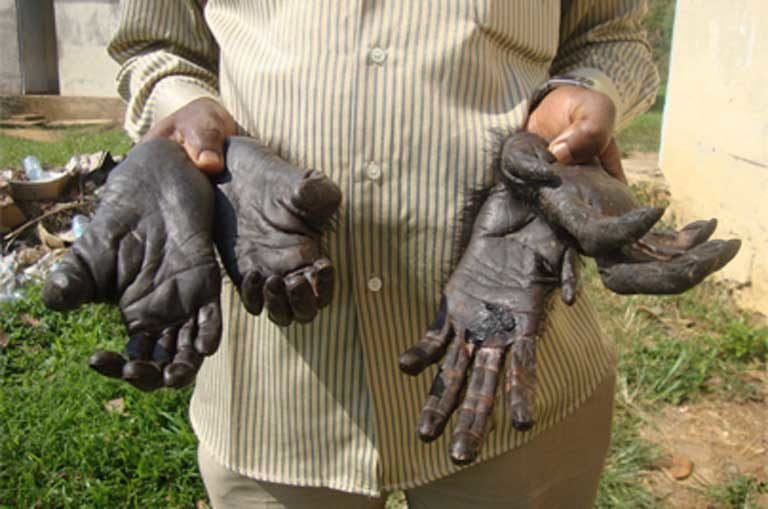- Primatologists in Cameroon have been heartened in recent years by the discoveries of new great ape populations scattered around the country. Unfortunately for these gorillas and chimpanzees, their numbers are being rapidly diminished by deforestation and human exploitation.
- Cameroon’s gorillas and chimps have long fallen victim to the bushmeat trade, but they are now being hunted vigorously to feed a national and international illegal trade in skulls and other body parts which are being exported to Nigeria, other West African coastal states, and especially to the US and China, either as trophies or for use in traditional medicine.
- Great ape trafficking operations in Cameroon are starting to resemble the ivory trade: International trafficking networks are financing hunters, providing them with motorbikes and sophisticated weapons. A spreading network of logging and agribusiness roads and a porous border between Cameroon and Nigeria are further facilitating the trade.
- The seriousness of this poaching hits home when one considers that during a four-month period in 2015, anti-poaching and anti-trafficking squads in Cameroon arrested 22 dealers and seized 16 great ape limbs, 24 gorilla heads and 34 chimpanzee skulls in separate operations around the country. Law enforcement is likely only detecting 10 percent of the trade.

Nests, footprints and dung have been leading primatologists to new gorilla populations in the Congo Basin nation of Cameroon for over a decade. In 2002, researchers discovered nearly 100 Western Lowland gorillas in the Ebo Forest in the country’s Littoral region. In 2011, scientists located 300-500 more gorillas in the Deng Deng National Park in Cameroon’s north.
Meanwhile, the Environment and Rural Development Foundation (ERUDEF) proclaimed: “Great Apes population on a possible rise in the Lebialem Highlands,” after researchers from that Cameroonian NGO found “a significant increase in the number of great ape signs” there.
News has been good regarding chimpanzee finds too. Researcher Martin Mikes, who has dedicated his life to conservation work in the Kedjom Keku Mountain Forest, believes he has found a population of previously unreported Nigeria-Cameroon chimpanzees, and has a video, dung samples and photos of low-hanging nests to back his claim. (Scientists believe there are as few as 6,000 individuals remaining of this rare chimp subspecies.)
Discoveries like these have sparked regional and local hopes for Cameroon’s great apes, whose populations overall have long been falling. The World Wildlife Fund, for example, estimated that the total population of gorillas and chimpanzees in the Campo Ma’an National Park in southern Cameroon at 851 individuals in 2008, but bumped that number up to more than 2,320 in 2011.
“Things are looking good for gorillas in Cameroon,” a Live Science reporter enthused in 2011, after the great ape discoveries in Deng Deng National Park.
But a dark reality clouds this bright assessment. Even as scientists discover new great ape populations, tremendous pressures due to illegal hunting and habitat loss have dogged great apes in Cameroon and surrounding Congo Basin countries. Wildlife crime investigators are especially alarmed at the fast growing — but largely unknowable — number of live and dead gorillas and chimps annually being traded via regional and global wildlife trafficking networks.
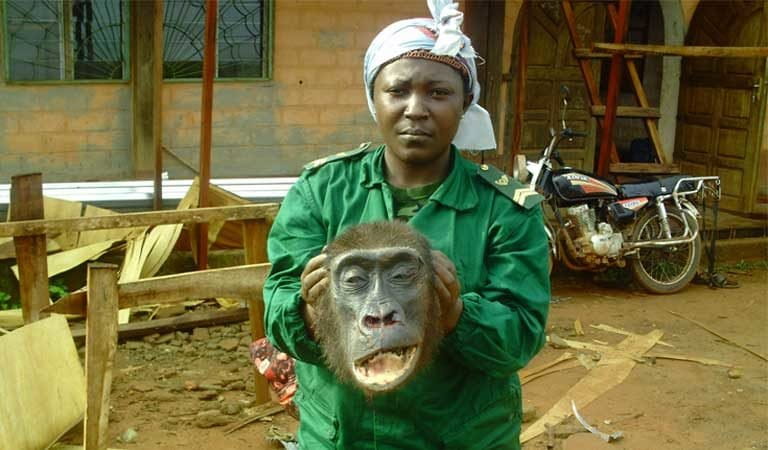
A booming trade in skulls and body parts
Conservationists have for decades blamed Central and West Africa’s high bushmeat demand as a leading cause for the trafficking of great apes in the Congo Basin. “There is a very big and growing market for bushmeat byproducts,” notes James Fawoh of Ape Action Africa.
But it is trade in body parts — particularly gorilla and chimpanzee heads, skulls and limbs — that is emerging as possibly the newest and biggest threat to Cameroon’s great apes populations, says Eric Kaba Tah, deputy director and head of media at the Last Great Apes Organization (LAGA), a non-profit that aids the government of Cameroon in wildlife law enforcement.
Evidence of the rapid expansion in body part trafficking is being seen across Cameroon.
Traffickers are being arrested “on a monthly basis” everywhere there are great apes: in the mountain forests and lowlands of the west, south, east and northern parts of the country. During a four-month period in 2015, anti-poaching and anti-trafficking squads arrested 22 dealers and seized 16 great ape limbs, 24 gorilla heads and 34 chimpanzee skulls in separate operations around the country.
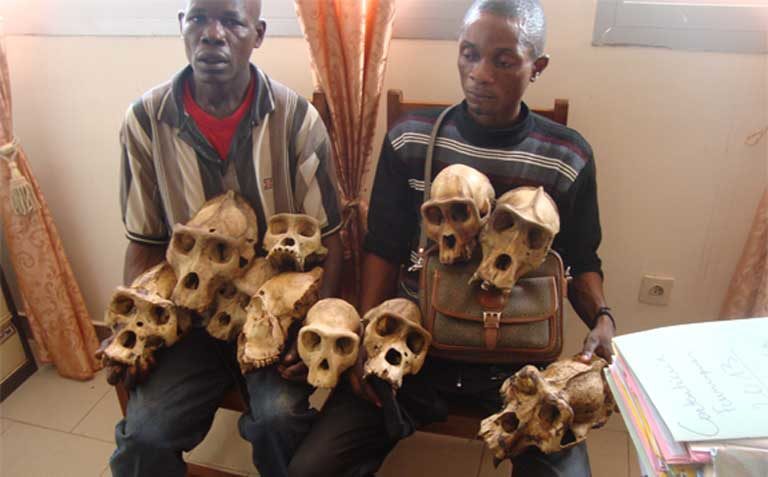
It is not clear whether ape parts trafficking is a new business, Tah says, or whether this is an old, but once uncommon, crime that has now gone viral. Its occurrence only came to the attention of law enforcement officials in the past four to five years. Now, with each passing day, wildlife protectors say they are seeing more examples of the parts trade, and so are gaining a broader understanding of the complex underworld and black market driving it.
It is now well known in the law enforcement community that great ape body part trafficking chains operate across national boundaries and between continents. The trade begins with poachers in forests all over Cameroon. It progresses through multiple levels of jobbers who process and pass along the body parts. Nigeria, and the entire West African coast, have been potentially identified as important transit points, and also as destinations for trafficked ape products. The United States and China are prime destinations for great ape body parts.
Ape skulls are prized as trophies in western countries, particularly the US, according to arrested traffickers interviewed by investigators. Anti-wildlife crime squads have also recovered jawbones and other body parts destined for export out of Cameroon. Most smugglers move the body parts out through Nigeria, facilitated by the long, porous border between the two neighbors.
Demand for great ape body parts in Cameroon and in West African coastal nations is mainly driven by a belief that the bones and tissues have medicinal, and even mystical properties and powers. Around the Campo Ma’an National Park in southern Cameroon, villagers have long boiled gorilla bones and fed human babies with the watery broth, believing it makes the infants’ bones stronger.

In the north and northwest parts of the country, great ape parts are used in similar ways to heal fractures and other bone dysfunction. Now, new demand appears to be coming from Chinese traditional therapists, who have stepped up their demand for great ape bones and other wildlife parts, says Fawoh who has participated in several studies and projects on wildlife protection in the Campo Ma’an National Park.
“The demand for bushmeat is already pushing gorillas and chimpanzees into extinction,” says Pamela Ghaife, an environmentalist in Yaoundé, Cameroon’s capital. “Now you have this demand for skulls and bones and other parts. This can only speed the rate of extinction. It is a frightening shift.”
A well-funded and organized trade
The poachers in Cameroon are no longer naïve local hunters looking to make a little quick cash on some bushmeat in a local market. They increasingly operate as well-armed and well-connected gangs, and can better navigate dense forests than park rangers and security forces.
Over the last few years, an explosion in the number of imported Chinese motorbikes into Cameroon has made it easier for traffickers to take rugged, un-policed routes through the forests to hunt great apes and to transport body parts out of the country undetected.
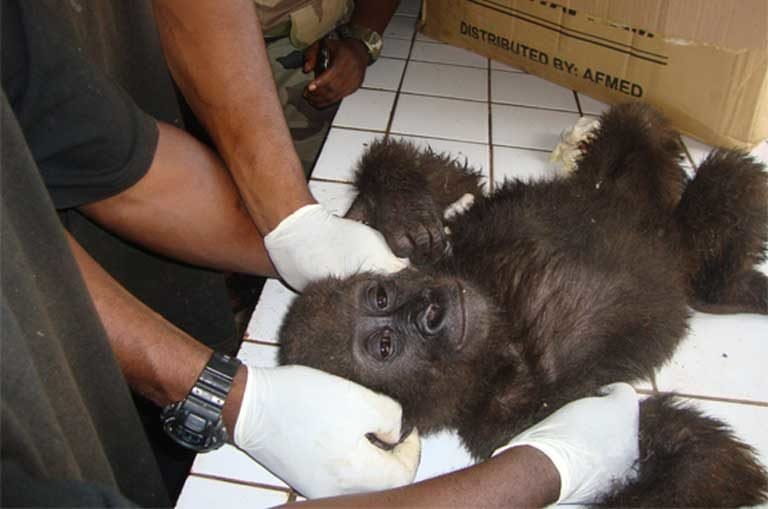
Also unintentionally facilitating the wildlife trade are logging operations (some legal, some not) and agribusiness concessions which have increased the number of back roads into the interior for the motorbikes to travel along.
In addition, there is evidence that well-financed international traffickers are paying to arm local poachers, and equipping them with motorbikes and outboard engines for previously hand-rowed wooden canoes. The growing lethal sophistication of the African great ape trade mirrors similar developments seen in recent years in Africa’s ivory trade.
“We have a better sense of the scale and threat of the problem,” says Tah. “It is only increasing. It is disturbing.”
One ape, two ape… counting great apes in the wild
Great ape populations in Cameroon are hard to pin down and an accurate inventory doesn’t currently exist. Scientific estimates are based on indirect inferences and are often only available for certain subspecies (like the Cross River gorilla), or in territories where scientists and conservationists have worked extensively, such as the Camp Ma’an National Park.
Nonetheless, researchers believe that great ape numbers have been brought down from tens of thousands of individuals to several hundred in some locales due to decades of poaching and the destruction of habitats from timber exploitation and the development of agricultural fields and human settlements. In some places, the estimates are down to mere dozens of individuals, and no one can say with any certainty whether and where local extirpations have occurred.

The Africa Conservation Society (ACS) has given the 250 to 300 rare and Critically Endangered Cross River gorillas, which are now confined to tiny highland forests along the border between Cameroon and Nigeria, only a decade before they are completely wiped out from the wild.
In both protected and unprotected areas throughout the country, it has become harder to spot great apes, and scientists now rely almost entirely on “signs of life” like nests and dung to study these populations, says Ghaife. “Most of the population estimates out there are grossly exaggerated and need to be revised.”
But whatever the real tallies may be, it is certain that unless action is taken to severely curb trafficking and deforestation trends, most of Cameroon’s remaining gorillas and chimpanzees could disappear in a matter of decades, conservationists warn.
Three ape, four ape… counting trafficked great apes
As hard as it may be to estimate great ape numbers in Cameroon’s wilds, it is even harder to obtain reliable numbers of how many are being trafficked as body parts. LAGA-assisted wildlife crime investigations have likely produced the best data indicating the scale of the epidemic.
The organization reports having recovered more than 200 ape skulls from arrested traffickers over the last two years alone. The majority, about two-thirds, belong to chimpanzees, while the remaining one-third are from gorillas. This disproportion could be a grisly indication of the relative populations of chimpanzees compared to gorillas remaining in the wild, but it unfortunately says nothing about the real numbers being traded, says Tah.

The 2015-16 body part confiscations represent only a tiny fraction of the slaughter going on, often committed under cover of darkness and very, very often with the complicity of corrupt public officials.
Tah believes wildlife law enforcement only catches about 10 percent of traffickers. If that’s true, the number of primate skulls leaving Cameroon in 2015-16 could have topped 2,000 gorillas and chimps — and that doesn’t count the number of animals processed as bushmeat or traded as live animals to become pets and zoo captives. “Worse could be happening,” Tah says.
It is known that ape meat continues to be a highly valued source of protein among wealthy city dwellers in Central and West Africa, and that it is feeding a growing culinary market among tourists seeking out exotic tastes. But what is also known among wildlife trafficking investigators is that the trade in body parts has all but taken over from bushmeat on the black market, and so is changing the nature of the threat to remaining wild populations.
The reasons are plain: first, unlike bulkier bushmeat and live animals, body parts are easy to handle, move and hide, says Ghaife. Body parts also have a higher “value per unit weight ratio”, which means traffickers find that dealing in parts is not only less risky but also more profitable. This is the same kind of calculation that has sustained and driven the global ivory trade, with devastating consequences on elephant and rhinoceros populations.
Driven by the money
It is very hard, say authorities, to calculate the value of the illicit trade in body parts. Law enforcement efforts over the past few years in Cameroon and elsewhere have driven traffickers further underground, and wildlife crime investigators are unwilling to disclose the amounts of money involved, fearing that word of the staggering profit to be made might fuel the carnage.

“One thing is clear, they are making a lot of money, otherwise, they would not be there,” says Tah. “If you look at the organization around this, you can tell that it is very lucrative. Ape parts used to be thrown away because they resemble human parts. Not anymore. This is a trade in its own right. It is done solely for the parts, rather than simply as a spinoff of bushmeat trade.”
Already, the trade in skulls, heads and limbs is considered more damaging to ape populations than the closely associated bushmeat trade or the hunt for pets. It is leading poachers to kill more animals and bringing in new players, says Ghaife. Bushmeat poachers, who used to dump ape limbs and heads in the forest, are now stocking them, since the market for body parts appears to be getting bigger than the demand for ape meat.
“Traffickers are [now] generally well-organized,” says Tah. “With the kind of professionalism we are seeing, it can only be bad news for conservation and for the remaining apes roaming in the wild. [Traffickers’] destructive professionalism [will] hugely and negatively impact these populations,” unless something is done.
“Eyes on the ground”
Trade in great apes and their products is illegal in Cameroon and under the Convention on International Trade in Endangered Species of Wild Fauna and Flora (CITES). After years of laxity regarding the trade, the central government stepped up law enforcement over the past decade. It signed Memoranda of Understanding with wildlife enforcement organizations like LAGA, and expanded the number of security forces and prosecutors to conduct investigations and arrests.
Today, the rate of arrests has stunned the country — prosecutions have soared by 80 percent. Wildlife crime stories now find prominent space on radio and television and in newspapers.
Robust law enforcement remains critical to creating deterrence, even though not every crime can lead to arrests, prosecutions, fines or a news story, says Tah. “We have to keep investigating, prosecuting and exposing traffickers so that the rest of the population understands that it is a criminal and dangerous enterprise.”
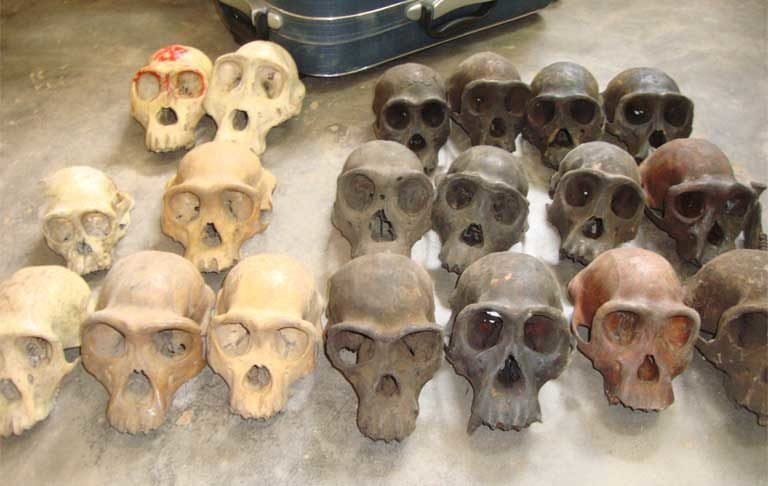
Over the years, communities have come to play a more central role in this process. Even though law enforcement has grown more sophisticated over time — involving undercover agents and informants — anti-poaching squads still rely heavily on intelligence from local community members. “They have the eyes on the ground to see what is going on before we ever do,” explains Tah.
Still, he admits that wildlife conservationists and law enforcement have only begun to scratch the surface of the growing menace of body part poaching. “It is a tough one,” he says. “This is a new phenomenon and we are still doing investigations to fully understand it.”
Ending the slaughter of great apes will be a race against time, not only in Cameroon but throughout Africa, concludes Fawoh. “If nothing is done, Africa will lose all of its wild great apes in 15 to 20 years.”
